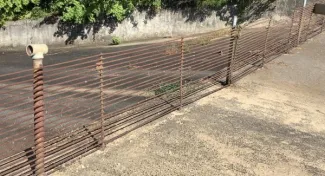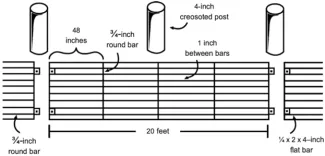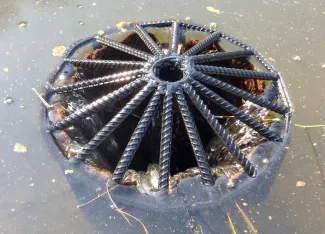Wildlife Department biologists receive numerous calls throughout the year from landowners regarding all sorts of farm pond issues. One of the most popular questions is, “how do I remove aquatic vegetation?”
Though there are several ways to remove or reduce aquatic vegetation in ponds, a common low-cost method is stocking grass carp (also known as white amur). However, grass carp, a fish native to Asia, is a river specialist…meaning they like to go with the flow.
I recently received a call from a landowner who stocked multiple grass carp a few years back with no results. After talking for a bit, I asked them if they had installed a screen on their standpipe or a fence on their spillway. They told me they hadn’t. Unfortunately, I had to tell them their grass carp were downstream somewhere eating someone else’s weeds, and for that landowner, they were back to square one. A spillway screen could have saved them money and heartache.


So, getting back to the original question, does my pond’s spillway need a screen? The short answer is: Yes, if you want to keep certain fish in your pond. Much like the grass carp, fish that are more likely to “escape” your pond originate from rivers. Examples of these “jailbreak prone” species include hybrid striped bass, common carp, white crappie, and green sunfish. These fish will go with the flow if you don’t “put them on lockdown”.
Despite their benefits, spillway screens come with their own set of issues. The main one being that they also hold back debris such as logs, sticks, trash, and rooted vegetation. In fact, many pond construction experts advise against installing spillway fences because they will catch debris moving through your pond. This can result in flooding surrounding property as well as the undercutting of your spillway and dam if the screens aren’t kept clean. So, keep in mind that spillway screens require maintenance!
If you’re interested in a spillway fence or standpipe screen, I’ve provided a material list with basic designs below. Good luck!
Suggested fencing materials:
- 5-foot x 2-inch metal posts or treated wooden posts
- 6-foot t-posts
- Concrete
- 20-foot pieces of 3/4-inch rebar
Suggested standpipe screen:
- 1/2-inch welded rebar

References:
Keep Your Pond in Good Condition. Marley Beem, Mar. 2017, Oklahoma State University Extension |Id: NREM-9212
Managing Pond Fisheries in Oklahoma. ODWC, 1995
Ponds - Planning, Design, and Construction. USDA, NRCS, 2000, Agricultural Handbook 590
Keith Thomas, a Fisheries Biologist of more than 30 years with the Oklahoma Department of Wildlife Conservation, unexpectedly passed away in late October.
Keith began his career with ODWC in 1988, and transferred to the Oklahoma Fisheries Research Lab in Norman in 1990. During his time with ODWC, he was involved in numerous pond-related technical assistance requests and phone calls from landowners, and he contributed at least six articles to the Your Side of the Fence newsletter. Keith was also involved in the Close to Home Fishing Program, a partnership between ODWC and municipalities across the state to provide fishing opportunities in urban areas.
Through sharing knowledge in person and in print, and by introducing both kids and adults to the sport of fishing, Keith left an indelible impact on the natural resources of the state and countless lives by sharing the joys of fishing and Oklahoma’s outdoor opportunities.